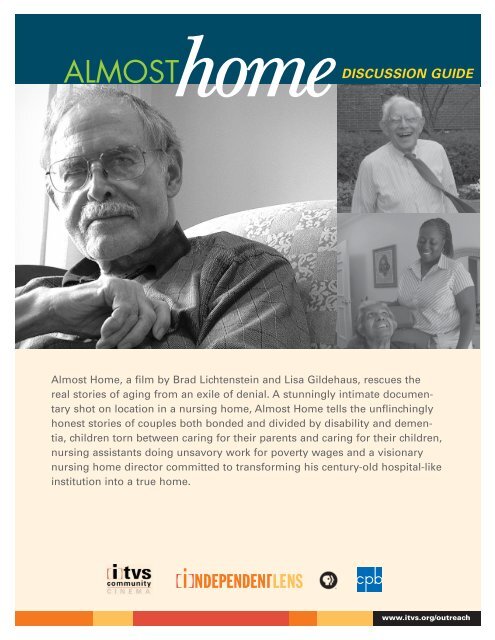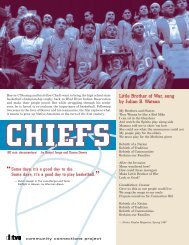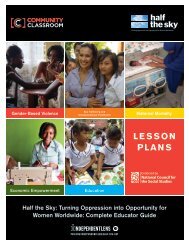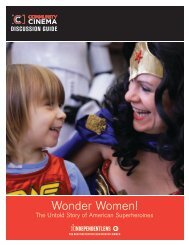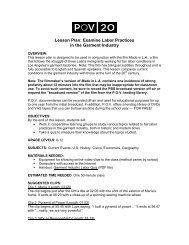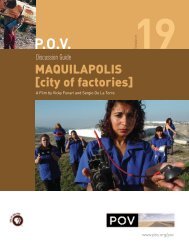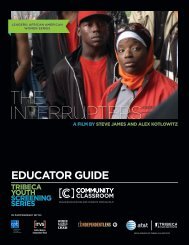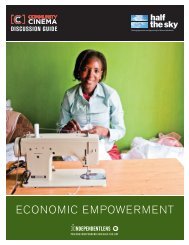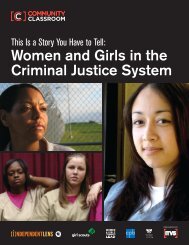Discussion Guide - PBS
Discussion Guide - PBS
Discussion Guide - PBS
- No tags were found...
Create successful ePaper yourself
Turn your PDF publications into a flip-book with our unique Google optimized e-Paper software.
ALMOSTGUIDEhomeDISCUSSIONAlmost Home, a film by Brad Lichtenstein and Lisa Gildehaus, rescues thereal stories of aging from an exile of denial. A stunningly intimate documentaryshot on location in a nursing home, Almost Home tells the unflinchinglyhonest stories of couples both bonded and divided by disability and dementia,children torn between caring for their parents and caring for their children,nursing assistants doing unsavory work for poverty wages and a visionarynursing home director committed to transforming his century-old hospital-likeinstitution into a true home.www.itvs.org/outreach
ALMOSThomeFROM THE FILMMAKERSI guess I shouldn’t be surprised that we Americans are capableof pretending that we’ll never age. After all, I do the same.I don’t have plans for plastic surgery, nor do I have a medicinechest full of antiaging creams or extravagant vitamins.But I must admit that I fear being old and feeble just like thenext person. Sure, if you have your health, it’s fine—a timeto enjoy your collected experiences and knowledge. But ifyou don’t have your health—then what?That’s why I made this film. First, to confront the reality ofaging long before I arrive at whatever age is the tipping pointfrom middle to old. Second, to explore the “then what?”What are we, as a society, going to do with each other whenage causes us to become more dependent?After 14 months of filming and nine months of editing, I don’tknow for sure. What I’ve learned is that the most importantfactor that affects our experience as older adults is the kindsof relationships we experience. Medicine may keep our bodiesalive, but what makes us human is our ability to love,hate, desire and engage—to not be “written off.” Caringfamily and extraordinary friends will surround some of uswhen we are old. But many of us will not be so lucky. We’llneed the kind of care that St. John’s and others in the fieldstrive to achieve.boomers age, and they’ll have more responsibility as wechange the culture of long-term care. Is it really fair to asksomeone to do our most important and intimate care forpoverty wages?Aging is hard. For ourselves. For our country. Making thisfilm didn’t alleviate all my fears. And it didn’t make me magicallyin tune with my own aging. But it pushed me in thatdirection. And it made me realize that we cannot tolerateinhumane, institutional care. None of us deserves to bepatronized, regimented or marginalized when we are old.ALMOST HOME is just a movie. But a movie can be powerful.It can inspire us to change how we care for elders. It can helpus trade denial for clear planning in our own lives. It canignite our capacities for empathy by telling stories that reflectour own lives. If ALMOST HOME does any of this for you,then it will have been well worth the effort.Thank you for watching.But do you know what? It’s hard. I learned firsthand, filmingcountless meetings, long days and nights on the nursinghome floor, and dozens of interviews. Care giving is anindustry that modeled itself on the hospital. Chucking schedules,letting people eat when and what they want, gettingrid of silly regulations all sounds great—but it is hard to do.Economic realities and system entrenchment makes it a grailof a goal. And beyond that, the majority of direct care workersget paid next to nothing. We’ll need more of them as theINDEPENDENT TELEVISION SERVICE (ITVS) 501 YORK STREET SAN FRANCISCO, CA 94110 PHONE: 415.356.8383 EMAIL: ITVS@ITVS.ORG WEB: WWW.ITVS.ORG/OUTREACH PAGE 1
ALMOSThomeTHE FILMThe setting is St. John’s on the Lake, a continuingcare retirement community in Milwaukee,Wisconsin. The drama is inherent in the lives ofresidents and staff—the real stories of livestouched by aging: couples both bonded anddivided by disability, children torn betweencaring for their parents and caring for theirchildren, nursing assistants doing emotionallydemanding work for poverty wages, healthy eldersfearful of moving to the “dreaded” nursinghome, and a visionary nursing home directorcommitted to changes that would mold thesedisparate lives into a nurturing community.People Who Appear in Almost HomeRESIDENTSLloyd HerroldEdie HerroldArienne BalserRalph NelsonAmy Polly SmithDolores HaigBob Haig (Dolores’s husband)Mary GriffithVISITORSEdie Herrold Jr.Amy Blumenthal (Arienne Balser’s daughter)ALMOST HOME captures every nuance of thecomplex dynamics involved in transformingSt. John’s from an institution based on efficientstaff and compliant residents into a responsiveand respectful “family” in which people investone another’s lives with meaning. FilmmakerBrad Lichtenstein doesn’t oversimplify or sugarcoat.In the end, that approach gives thedocumentary a hopeful tone, because throughthe failures and frustrations, genuine caringcontinues to provide a guiding light.STAFFJohn George, AdministratorKathie Eilers, PresidentNancy Tischer, Director of Nursing EducationSharon Prusow, Director of NursingRenée Anderson, Director of FinanceAnna Jonas, R.N.Erika Stoving, R.N.Enchantra Cosey, C.N.A.Yvonne Robinson, C.N.A.Tamica Burris, C.N.A.Jeraldine Cosey, C.N.A.Marilyn Farsee, C.N.A.Megan Hannan, Person First ConsultantINDEPENDENT TELEVISION SERVICE (ITVS) 501 YORK STREET SAN FRANCISCO, CA 94110 PHONE: 415.356.8383 EMAIL: ITVS@ITVS.ORG WEB: WWW.ITVS.ORG/OUTREACH PAGE 2
ALMOSThomeBACKGROUND INFORMATIONAccording to projections by the U.S. Census Bureau,between now and 2030 the number of Americans aged 65and older is expected to double, from about 36 million to71.5 million (20 percent of the country’s total population).By 2050, the 65+ population will grow to 86.7 million.The Health Insurance Association of America estimatesthat by 2020, 12 million older Americans will need longtermcare. Most of those people do not have insurancethat would cover such care.Links to most of these initiatives can be found atwww.pioneernetwork.net/index.cfm/fuseaction/Initiatives.DocList/CategoryPK/Articles.cfm.As baby boomers have looked to place parents in carefacilities and have contemplated their own eventual needfor such facilities, some have begun to rethink andreshape traditional institutional models. St. John’s on theLake, which is profiled in ALMOST HOME, is part of alarger movement implementing alternatives to traditionalcare. To find out more, you might look for information onthese frequently cited projects and approaches:Action PactCulture ChangeEden AlternativePerson-first carePerson-centered carePioneer NetworkWellspringINDEPENDENT TELEVISION SERVICE (ITVS) 501 YORK STREET SAN FRANCISCO, CA 94110 PHONE: 415.356.8383 EMAIL: ITVS@ITVS.ORG WEB: WWW.ITVS.ORG/OUTREACH PAGE 3
ALMOSThomeTHINKING MORE DEEPLYBefore ViewingIf you were looking for an ideal nursing home for yourself,what would you look for? Where would it be located? Whatkinds of services would it offer? What would your room looklike? Who would be with you?What are your concerns about aging? What do you fear themost and why?Have you done any planning for a possible time in your lifewhen you would not be able to care for yourself or care for aspouse? What do those plans include?After ViewingGeneralIf you could have a conversation with anyone in ALMOSTHOME, whom would you want to talk with and what wouldyou want to talk about? Why?Describe a moment in the film that touched your heart or thathit close to home. Did that moment change your thinking inany way or cause you to want to take action? If so, describethe change.What did you learn from the film about aging or the experienceof children who are dealing with aging parents?Person-First CareHow is what you see in ALMOST HOME like or unlike nursinghomes that you have been in or heard about? Would youwant to live in St. John’s? Why or why not? Would you wantto work at St. John’s? Why or why not?Finding Common Ground• The administrators of the nursing home have asked thestaff to create a “homelike” atmosphere. What do you thinkthey mean by that? Does everyone share the same vision ofwhat a home is like? How might an institution bridge thegap if they find that residents and staff members have differentvisions of “homelike”? What is your vision of“home”?• Administrators acknowledge that most of the people whowork at St. John’s could never afford to be residents there.What kinds of difficulties do you think that situation creates?How might the socioeconomic class differences challengeattempts to create community?• What extra challenges are added to the mix when residents(who at St. John’s are all white) and CNAs (who atSt. John’s are predominantly black) come from different ethnicand racial backgrounds and neighborhoods? Might thecommunity at large benefit from some of the strategies thatSt. John’s uses to bridge the gaps between staff and residents?If so, what might people learn from the St. John’sexperience?• There is no doubt that staff members care about (not justfor) the residents of St. John’s. So what is the source of theresistance to some of the suggestions and policy changesmade by administrators? If you were running the facility,what would you do to overcome that resistance?What specific practices are being implemented at St. John’sthat you would like to see more nursing homes adopt? Whatdo you think the impact of those practices is on the staff?What is the impact on the residents?Administrator John George encourages his staff to approachresidents as if they were family. What do you think he meansby that? Is it different from approaching residents as a professional?If so, how? In your view, how does care change whencaregivers know the values, accomplishments and experiencesof the people in their care?INDEPENDENT TELEVISION SERVICE (ITVS) 501 YORK STREET SAN FRANCISCO, CA 94110 PHONE: 415.356.8383 EMAIL: ITVS@ITVS.ORG WEB: WWW.ITVS.ORG/OUTREACH PAGE 4
ALMOSThomeSUGGESTIONS FOR ACTIONTogether with other audience members, brainstorm actionsthat you might take as an individual and that people mighttake as a group. If you need help getting started, you mightbegin your list with these suggestions:• Investigate the approaches to care offered by the nursinghomes and assisted living facilities in your community.Host a special screening of ALMOST HOME for policymakers and staff to begin a dialogue about how they mightuse some of the ideas in the film to improve the care theyprovide.• Help staff and residents of nursing homes and assistedliving facilities who are doing interesting things in yourcommunity to share their story. Invite them to speak atyour school, civic group, church, club and so forth. Alertjournalists to their work.• Collect census information from your community to estimatehow many nursing home beds, assisted living facilitiesand adult day-care spots will be needed by residentsover the course of the next 20 to 30 years. Assess the numberof facilities currently available. Convene a task force ofstakeholders to make sure that the capacity of the facilitieswill meet the needs of those likely to require services.• Many of the stresses brought on by disabilities associatedwith aging can be lessened by planning ahead and by makingsure that everyone in your family understands yourintentions. Gather family members to review plans for longtermcare, medical decisions, finances and how decisionswill be made should you become incapacitated. Be surethat all of your loved ones have taken care of the basics ofestate planning, including having a valid will, health careproxy and durable power of attorney.For additional outreach ideas, visit itvs.org, the website ofIndependent Television Service. For local information, checkthe website of your <strong>PBS</strong> station.Before you leave this event, commit yourself to pursue oneitem from the brainstorm list.RESOURCES FOR FURTHERSTUDY AND ACTIONTo Starthttp://www.almosthomedoc.org/ – The film’s website includesresources on understanding aging and dealing with relatedchallenges and links to other organizations involved indeveloping person-centered care.General Information and Advocacywww.aarp.org – American Association of Retired Personswww.owl-national.org – Older Women’s Leaguewww.ncba-aged.org – National Caucus and Centeron Black Agedwww.sagecrossroads.net – An online forum on science andpolicy related to aging hosted by the Alliance for AgingResearch and the publishers of Science Magazinewww.empub.com/sandwichgen.shtml – Put together by agroup of people who are caring for aging parents as well asfor minor children; provides links to key resources for the“sandwich generation”Nursing Homes and Person-Centered Carewww.nccnhr.org/ – National Citizens’ Coalition for NursingHome Reformwww.aahsa.org – American Association of Homes andServices for the Aging; resources section includes links toa variety of institutions and projects exploring alternativemodels of care. The AAHSA also runs the Institute for theFuture of Aging Services, a database of research projectsrelated to care of the aging.ALMOST HOME is a co-production of 371 Productions andWisconsin Public Television, in association with IndependentTelevision Service, with funding from the Corporation for PublicBroadcasting. Major funding was provided by the Helen BaderFoundation, the Jacob and Valeria Langeloth Foundation, and theFaye McBeath Foundation.ITVS COMMUNITY is the national community engagement programof Independent Lens. ITVS Community works to leverage the uniqueand timely content of IL’s award-winning independent films to buildstronger connections among leading organizations, local communities,and public television stations around key social issues and createmore opportunities for civic engagement and positive social change.ALMOST HOME WILL AIR NATIONALLY ON THE EMMYAWARD-WINNING SERIES INDEPENDENT LENS ONFEBRUARY 21, 2006 AT 10:00 PM. CHECK LOCALLISTINGS.INDEPENDENT TELEVISION SERVICE (ITVS) 501 YORK STREET SAN FRANCISCO, CA 94110 PHONE: 415.356.8383 EMAIL: ITVS@ITVS.ORG WEB: WWW.ITVS.ORG/OUTREACH PAGE 5


